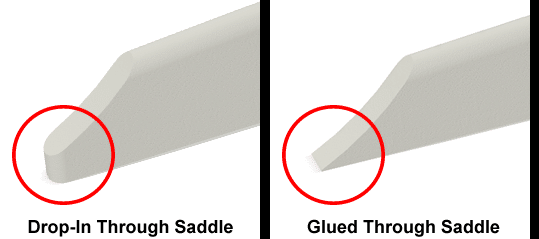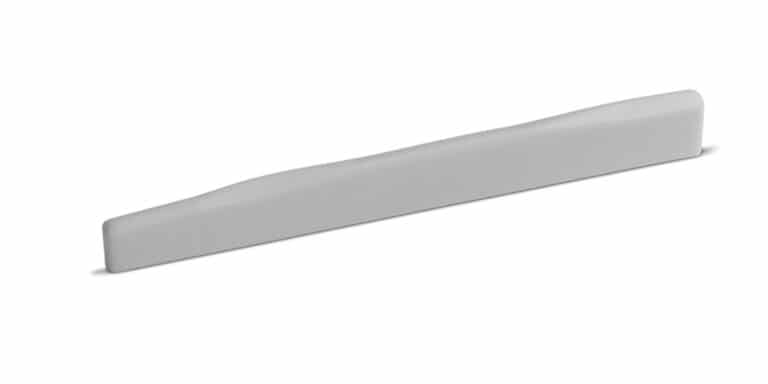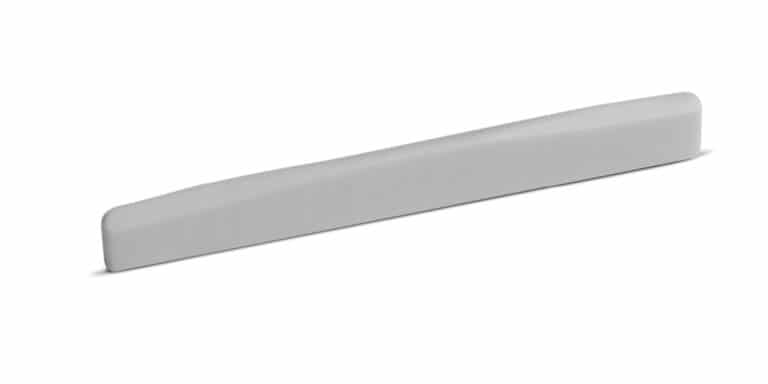Find the Right Saddle Size for Your Martin® Acoustic Guitar
Looking for a Martin acoustic guitar saddle? Martin began making guitars about two centuries ago, and thus determining the correct saddle for your Martin can be difficult as there’s no single saddle size.
This article provides steps to find the right saddle for Martin flat top steel string acoustic guitars built after 1915, but we also suggest that you measure your guitar’s bridge saddle slot for a proper fit. If you are not the guitar’s original owner, at some time someone may have installed a different saddle or have adjusted the saddle slot, or even installed a new bridge, resulting in different specs from the original factory ones.
Step One: Determine Compensation Pattern
Center Line Non-Compensated
Prior to the late 1990s, Martin guitars typically had center line non-compensated saddles. Some models made after the late 1990s also come from the factory with these. Please see our Guide to Non-Compensated Saddles for a discussion of center line non-compensated saddles.
You might be tempted to replace your Martin’s original non-compensated saddle with a wave compensated saddle. However, we typically advise against this. In deciding to use a non-compensated saddle, Martin would have factored a guitar model’s saddle slot angle, scale length, string spacing, string gauge, and other factors. Replacing a non-compensated saddle with a wave compensated saddle could have a negative impact on your intonation, particularly if your string spacing does not match the saddle compensation pattern.
At first glance, it might appear that the wave compensated saddle is similar to the center line non-compensated saddle, but with the B and bass E strings pushed back toward the bridge pins and lengthening the scale for those two strings.
However, all string positions but the treble E’s differ on the wave compensated saddle versus the center line non-compensated saddle. Let’s look at two images of a center line non-compensated saddle along with a wave compensated saddle looking down on the saddle top. Both saddles have a three degree saddle angle. The thin blue line shows approximately where each string sits on the saddle top, but this will vary depending on bridge string spacing.


You can see that with a center line non-compensated saddle, all the strings sit in the center on the saddle top. However, the three degree saddle angle serves as a form of compensation, by making each string from the treble side to the bass side progressively longer.
With a wave compensated saddle, the treble e string also sits in the center; however, notice that the B and bass E strings sit back further toward the bridge pins, and the G, D, A strings all sit forward toward the soundhole. As such, replacing a center line non-compensated saddle will affect intonation on all strings except the treble E. If you have a center line non-compensated saddle, but with a sharp B string, a wave compensated saddle might correct that string’s intonation problem, yet cause problems with your G, D, A, and bass E strings.
Forward GDA Wave Compensated Saddles
In the late 1990s, Martin started using forward GDA wave compensated drop in saddles out of Micarta, and then later out of bone and Tusq. Read more at our Guide to Wave Compensated Saddles. Very minor length/height/thickness and compensation differences appear between the Micarta, Tusq and bone wave compensated saddles, and these are typically interchangeable.
These saddles are typically 74 mm long, however, we’ve had customers report saddle lengths anywhere from 73.5 to 76 mm, so please measure your current saddle and slot. Height is typically around 10 to 11 mm, with a 1.5 to 2 mm bass/treble edge height difference.
You’ll often see Martin style saddles for sale listed as having a 3/32” thickness, or 2.38 mm. However, in our experience, a slightly thicker saddle of 2.5 mm typically works better for a snug fit. Because of humidity’s effects on wood, you might also find that your saddle slot is a touch thicker than this, and you may need a slightly thicker saddle.
A Note on Radius
The majority of Martin style saddles you find online will have a 16 inch top radius to match the 16 inch fretboard radius common to many Martin guitars. However, you will find some saddles online listed with a flatter top radius, such as a 20 inch radius, as some Martins have apparently been made with a saddle and/or bridge with a 20 inch radius.
We often advise that you match your saddle and fretboard radii for better playability, but many people wish to maintain the factory settings. You can check your saddle and fretboard radii either with machined radius gauges, or by using printed ones.
We make our Martin style saddles with a 16 inch radius because in our experience, Martin saddles and bridges are typically made with a 16 inch radius. Additionally, our customers almost always prefer a 16 inch radius saddle for their Martins.
Step Two: Determine Installation Method
Drop In Saddle
A drop in saddle means that the saddle is not glued in and is thus dropped in and removed without the need to add or remove glue. However, drop in does not mean that these saddles are one-size-fits all, and if you purchase a new saddle, you will likely need to adjust it to your specific guitar’s saddle slot, as well as to your playability preferences.
Per VintageMartin.com, Martin has used short, drop in saddles for most of its long history. However, it largely used glued through saddles, in which the saddle goes all the way through the bridge, from around 1916 to 1965. As such, the highly sought after pre-war Martins typically have a long through cut saddle, as have later reissue guitars based on those models. But then in 1965 Martin shifted to short, drop in saddles, which has led many to believe that the long, through cut saddles came first. For more information on the history of Martin saddles please visit the following link: The Evolution of Saddles on Martin Guitars.
Drop In Through Saddle
Although from the outside these appear to be the same as traditional glued through saddles (discussed in next section), the drop in through saddle combines the relatively easier installation of a drop in saddle with a simulated look of a through saddle. These are easily identifiable by looking at the ends, which will be rounded and have a bit of height to fit in the slot, similar to other drop-in saddle ends. Conversely, glued through saddles will have flat ends with very little height, as shown in the image below.

Vintage Series Martins have used drop in through saddles since 2003.
These saddles are typically center line non-compensated.
Glued Through Saddle
Martins built from around 1916 to 1965 often have a through saddle, which goes all the way through the bridge and is often, but not always, glued in place. In the 1990s, Martin began making models with long through saddles again. For example, pre-2003 Vintage Series Martins had through Micarta saddles that were glued in.
Many Martin Authentic, Marquis, and Golden Era models also have through saddles glued in similar to how 1916-65 Martins have. However, the newer through saddles have a deeper routed slot, whereas the 1916 to 1965 through saddles have a shallow slot.
These saddles are typically center line non-compensated.
This type of saddle requires significant skill and knowledge to do the replacement and we advise that you hire a professional guitar technician to perform the work.
Step Three: Determine Saddle Length
Martin steel-string flat top acoustic saddle lengths get confusing as you’ll often hear “short,” “standard,” and “long,” yet see differing lengths for the “long” saddles. To make things easy, we refer to Martin saddle lengths by their millimeter length specs. There are three common lengths: 74 mm, 95.3 mm, and 103.2 mm. Let’s discuss each.
74 mm Length (2.9 inches) Length
This is the most common saddle length seen on Martin Guitars since 1965 and is often referred to as a ‘standard saddle,’ or because it’s the shortest of the three, a ‘short saddle.’ The 74 mm length comes in center line non-compensated or wave compensated. Saddle slot thickness will vary from around 2.4 to 2.7 mm, even from the factory. Additionally, wood will subtly shift with humidity. The large majority of our customers report a 2.5 mm saddle and slot thickness. Please measure your saddle slot thickness before ordering a replacement saddle.
95.3 mm (3.75 inches) Length
The shorter of the ‘long’ saddles. These are typically center line non-compensated. Thickness is often around 2.6 to 2.8 mm.
103.2 mm (4 1/16 inches) Length
The longer of the ‘long’ saddles. These are typically center line non-compensated. Thickness is often around 2.6 to 2.8 mm.
Step Four: Determine Height and Bass/Treble Edge Height Difference
Acoustic guitar saddles often have a taller height on the bass side than on the treble for increased action height for the thicker bass strings. For many guitar brands, this bass/treble edge height difference is often around 1 mm, but for Martin guitars, this is often around 1.5 to 2 mm. Please see our article on How to Adjust Saddle Height on One Side More than the Other for more information.
Step Five: Determine Material
Martin saddles often come in Tusq, Micarta, or Bone. For information on tonal qualities of these materials, please see our article on What Is the Best Acoustic Guitar Saddle Material?
If looking for a replacement Martin saddle in Tusq, you have a number of options. Let’s review each.
Let’s start with Tusq’s Martin style forward GDA wave compensated saddle, Tusq Model 9110. This model is a wave compensated, drop-in saddle and listed on the GraphTech site as 73.66 mm long. These saddles are on the thick side, listed at 2.73 mm, so you will likely need to adjust thickness a bit. Top radius is 16 inches. If your guitar currently has a wave compensated saddle and you wish to replace it with Tusq, then this is the saddle to use. Available in either Tusq (white), or in the String Saver option (black), which contains PTFE for a slippery surface.
For non-compensated saddles, you might consider Tusq Model 9100, which has length, height, thickness specs similar to the 9110. However, a key consideration before buying the Tusq model 9100 is that it has a 22 inch top radius versus the 16 inch fretboard radius common to Martins.
If you need a taller, thicker, or longer saddle, consider Tusq Model 9000, but this will also require significant adjustments as it comes with a 14 inch top radius and a 3.16 inch thickness. You might also consider Tusq’s rectangular Tusq Model 9332, but please note that this has a 2.45 mm thickness, which might be a touch thin for many Martin bridge slots.
Micarta Martin style saddles are hard to find, but you can try searching ebay.com. You can get a rectangular Micarta blank from StewMac.
For bone saddles, you can view Martin’s website, or our Martin style saddles. You will find a number of other Martin style bone saddles by other manufacturers as well. Before purchasing any bone saddle, we advise you that you check the following.
First, ensure that the compensation pattern matches what you need. We’ve seen some bone saddles intended for Martins that have either B compensation or single wave compensation, rather than center line non-compensated or forward GDA wave compensation discussed eariler. The single and forward GDA wave compensation patterns are particularly difficult to distinguish from just online pictures, but the below pictures show the difference


The top image shows the Martin style 2.5 mm thick forward GDA wave compensation, with the treble E in the center, B and bass E pushed back, and G, D, A pushed forward. The bottom image shows a 3.2 mm thick single wave compensation, with the treble E, B, A, and bass E pushed back, and G, D pushed forward.
You also will see “shaped” saddles advertised, which have a top radius cut, but no compensation or rounding of the top edges. These saddles are made for luthiers who plan to do the compensation by hand.
Second, ensure that the saddle has the correct top radius. As mentioned previously, a large number of Martins will have a 16 inch radius fretboard and bridge, but you’ll find saddles intended for Martins with different radii.
Third, check thickness. Our customers have widely reported that a 2.5 mm thickness works best, although sometimes a slightly thinner or thicker saddle is needed. However, you’ll find many saddles intended for Martins listed with a 3/32″ thickness, which translates to 2.38 mm, which may be a touch thin. You’ll also see a number of saddles listed with a 3.0 mm thickness. Although this might seem fine as you could adjust as needed, adjusting saddle thickness by hand is tedious as there’s little to grip on to. Adjusting around 0.1 or 0.2 mm thickness by hand typically isn’t a problem, but will take a good 15 minutes or so and you’ll likely maintain a consistent thickness. However, doing 0.5 mm thickness reduction by hand will take about 30 to 45 minutes and may result in an uneven thickness.
Finally, check bone quality. Processing bone takes a significant amount of time. This time can be reduced with the use of harsh chemicals, which also reduces costs. However, the result is weaker bone that produces medicore tone and won’t last as long as properly prepared bone will.
Which Saddle Does Your Martin Need?
Are you still wondering which type of saddle your Martin acoustic guitar needs? Please contact us with all of the below information.
• Guitar Year, Model
• Current Saddle Length, Height, Thickness, Radius
• Guitar Saddle Slot Length, Thickness (if different from saddle specs)
• Bass to Treble Edge Height Difference
• Current Saddle Compensation Pattern (please send a picture if you are not sure what type you have)
• String spacing at the bridge
We will respond within 48 hours.
